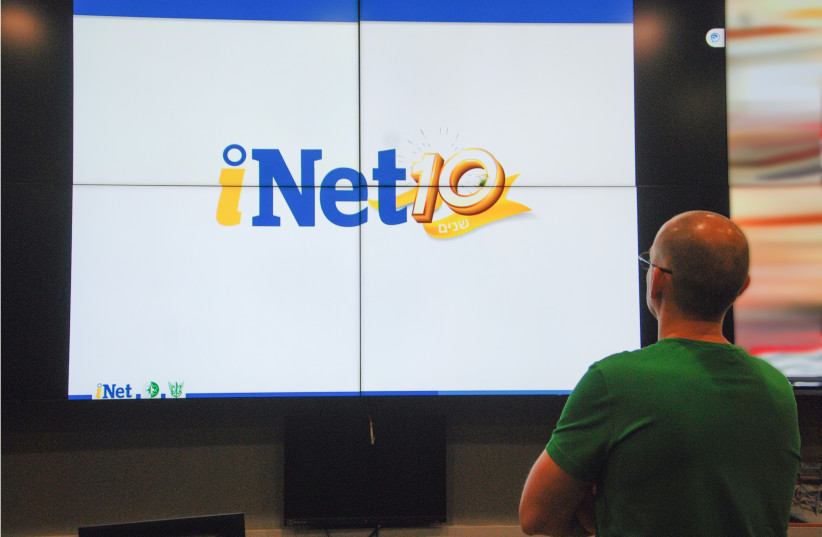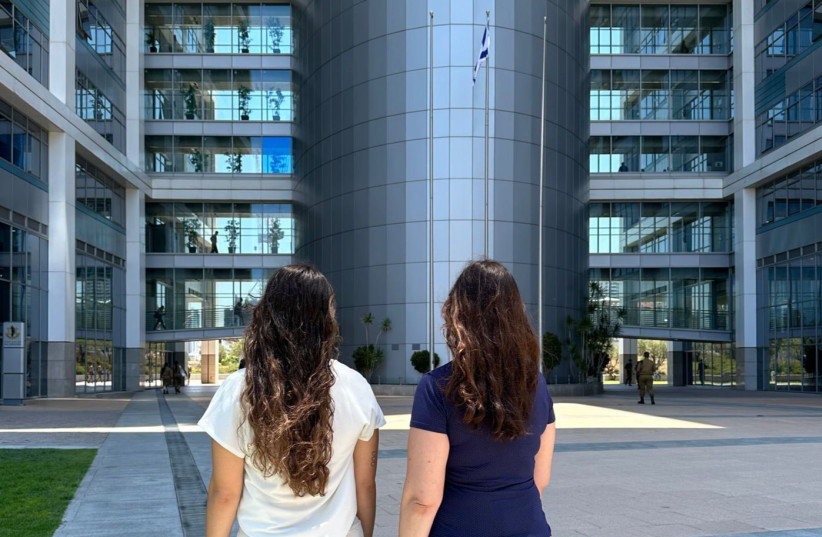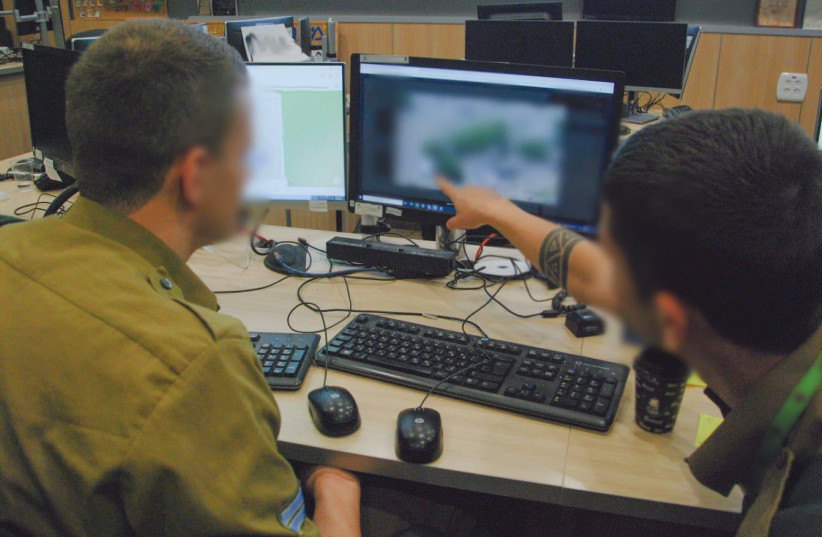A couple of dozen computer analysts, editors, and graphics personnel typed and clattered away deep inside “the pit” of Israeli military intelligence. Located in a labyrinth of subterranean tunnels under the IDF headquarters in Tel Aviv, I-NET is the 24/7 operations center that synthesizes open-source intelligence for Israel’s defense establishment.
The Jerusalem Post Magazine’s visit to I-NET was the first by an English-language news publication.
The room pulsated with charged energy as the staff kept their eyes trained on 15 large video screens running news and other coverage of Israel, the Middle East, and other countries across the planet.
I-NET is the IDF and Israeli intelligence community’s largest internal online resource. Established in 2013, I-NET focuses on following and curating open-source information for Israel’s intelligence community. It was created when top officials realized that their standard traditional apparatus could not handle the massive volume of data from the billions of items coming in.
With simultaneous cultural changes taking place globally regarding how people absorb information, a new platform – which became a large new unit – was needed to edit and transfer information relevant to the intelligence community. Part of the goal was to present the information in a user-friendly format that the head of IDF intelligence, the prime minister, and other top officials could process easily and efficiently.

I-NET also has some traditional aspects. There are specially trained analysts and editors fluent in Arabic and some also in Farsi, who are able to better follow regional news with regard to Israel’s Sunni neighbors, as well as Iran and its proxies.
Twice a day, at a minimum, around 11:30 a.m. and 6 p.m., I-NET sends an electronic edition directly to the head of IDF intelligence, which he can read on his cellphone as he exercises or performs a variety of other activities. Besides those two special editions, I-NET sends concise “pushes” directly to top defense and political defense officials when a special event occurs, the same way civilian media give sudden breaking news updates.
T.
T., the current chief at I-NET, was dressed in civilian clothing and seemed unusually open and outgoing for a member of the intelligence establishment. While most of I-NET personnel are officers in uniform, a sizable minority are civilians with previous relevant experience crossing over between intelligence and the civilian media. As well as T.’s extroverted personality, the secret sauce that makes I-NET function appears to be the media-savvy and open-source attitude attached to this secretive intelligence establishment.
Despite T.’s personal openness, the Magazine had to undergo several distinct security checks and receive additional clearances to enter deeper and deeper into the intelligence sanctum.
T. estimated that today’s defense establishment still relies on 60% of its data being collected from classified sources, whether by human spying, signals intelligence, or other cyber-tech means. But the revolution is that there has been a sharp increase in the critical data being analyzed, with around 40% now coming from open-source intelligence such as I-NET provides.
When the prime minister or security cabinet members read the news, they need to be able to get a broader view of what all the disparate information means. They need to know which pieces of information are “noise” and could lead down an endless rabbit hole; and what information is disseminated intentionally as disinformation.
The fact that I-NET is distributed exclusively by electronic means is a separate revolution in the speed at which key decision-makers can receive data. This is in contrast to most of modern intelligence history, where special briefing papers were put together and physically transported from office to office.
The prime minister still receives a daily morning intelligence briefing on paper, but a significant amount of what he, the IDF chief, and the IDF intelligence chief process is now strictly electronic, flowing automatically from I-NET throughout the day.
According to T., “The intelligence situation report is presented to the IDF chief on a weekly basis, which involves the direct preparation and work of the chief of IDF intelligence analysis and his aides, along with the I-NET media team.
“Each week, we decide what central issues and messages should be highlighted, and on that basis we build a visual product which conveys the intelligence story – including infographics and videos – and which [issues] the IDF intelligence analysis chief presents to the top echelons,” T. explained. He added that once the IDF chief sees the presentation, other authorized high-ranking persons are granted access to this I-NET work product.
Married and the father of two, T. is 37 and has a doctorate in Arab studies. He has been part of I-NET for 10 years, with previous experience working for IDF intelligence Unit 8200, as well as Channel 12’s news desk.
He called his job very challenging and exciting. “There are many challenges. We need to tell the intelligence story and develop a stellar product for high-ranking officials, while retaining the tip of the spear for open-source intelligence collection in terms of technological and media developments and practices,” he said.
T. provided the Magazine with access to a few of I-NET’s published items, though these are not available to the general public. These items came heavily redacted and were on topics that seemed innocuous, such as climate change. One of the I-NET articles from May 3 about climate change was titled “Hot, getting hotter, brutally hot: Escalating heat in the Middle East and its future implications.”
The report stated, “An additional potential impact could be manifested in the activities of the security forces in the overheated areas. Routine ongoing security patrols and military drills occurring in the context of constant, heavy, and extreme heat, and during weeks when the majority of the time the heat is heavy and extreme.”
Put succinctly, I-NET was warning that while there are currently a few days a year during which soldiers cannot fully train or perform certain duties or must do so under very strict conditions because of concerns about heat stroke, a larger portion of the year could start to fall into this category. The more days per year in which drills and routine patrols have limits, the greater the impact on the IDF’s readiness and ability to stay on guard at all times.
The same I-NET article warned of broader impacts on Israeli and Middle Eastern society in terms of dangers to health, especially in economically disadvantaged sectors. It also warned that larger portions of the Middle East may become uninhabitable, which could lead to major migration shifts, saying that by 2050, around 250 million people in the region could live in areas of extreme heat. Specific sectors where extreme heat will occur were blacked out by the IDF for national security reasons. Moreover, the I-NET article cautioned that the extreme heat could harm and overpower existing electrical, water, and transportation infrastructures.
Another item from I-NET on June 18 obtained by the Magazine was titled “Cryptocurrency: The way they are traded and the security context.”
This item said that “the use of cryptocurrency represents a growing danger that terror organizations and countries with sanctions on them will use them” to avoid their financial moves and sanctions violations being detected. Further, the item noted that there are already hundreds of millions of cryptocurrency users and that the market value of the industry has grown to around one trillion dollars. Next, the I-NET article described how cryptocurrency operates in the digital world of blockchain and digital “wallets.”
T. also introduced two deputies to the Magazine.

A.
A., 41, is from Shoham and has two children. She previously served as an Air Force intelligence officer, as well as working for YNET for a decade. She has been with I-NET for eight years and is a senior editor. A. said that her challenge is to “connect the text to the broader political and military context,” as well as to make the headlines and presentation clearer and more likely to draw the attention of top decision-makers.
There have been instances when she has fielded inquiries from top aides to the prime minister or foreign minister to better understand an item they received from I-NET to their cellphones. In addition, she has received calls from the IDF chief’s office in the middle of the night about I-NET items.
A. also runs a course to educate new recruits to I-NET to meet its various journalistic and intelligence standards, and she works to enhance I-NET’s online tools for distributing information. She is also heavily involved in managing its podcasts, another way to inform.
During the COVID-19 pandemic, I-NET, like many other organizations, moved significant aspects of its operations onto Zoom. Although this slowed certain things down, A. said that the experience of using Zoom more frequently later helped her enhance running online interviews with IDF officials and enabled her to produce aspects of I-NET using the VOD (view on demand) format.
She added that I-NET has its own “green screen” and other visual tools to enhance the production quality of such video-oriented media.
E.
At 28, E. already has nine years of experience at I-NET and is now a top official in the graphics department. She said that the uniqueness of her role is that she has to be an expert in graphic arts and technology and must also combine that with expertise about the range of Hezbollah speeches and public statements, and about other Israeli adversaries and present them in a way that will specifically speak to Israel’s intelligence community.
This involves a mix of creatively delivering certain messages, sometimes with cultural references to Harry Potter or other media sensations, while not losing the serious developments behind those messages.
T. discussed the special challenges associated with changes in technology, personnel, and the practice of intelligence itself.
He said that when I-NET hits the right combination of these factors, it has significant influence over actual policy. He cited examples where the head of IDF intelligence analysis and other arms of the intelligence establishment jumped on information provided by I-NET.
Aspects of I-NET are like a regular website. During the recent May war in Gaza, the number of visitors to the site essentially doubled – a clear sign of success. There are also respectful, professional internal struggles within I-NET for more prominent placement of specific posts on the site. Some of these battles may go beyond I-NET, and intelligence officials more focused on the Palestinians than on Lebanon may seek to campaign for better placement of certain items with the hope of influencing top decision-makers.
Security and access
I-NET also has other dimensions which mark it as completely different from any other site.
For example, I-NET’s staff were privy to the expected timing of the May operation against Gaza the week before it happened, information which was kept classified from the general public.
If some websites like the New York Times have paywalls for specific content items, I-NET has a much more complex series of walls which have nothing to do with paying for a subscription. I-NET has layers of access that depend on the level of the visitor’s security clearance.

This means that the head of IDF intelligence can access the entire site, but middle-level intelligence management officials might only have access to certain inner domains, and lower-level intelligence analysts might only have more basic access. There is also issue-based access, tracing whether someone is assigned to the northern command and needs access to information about Hezbollah, whereas someone else might only have access to intelligence about Hamas in Gaza.
T. explained that as soon as someone switches from the northern command to the southern command, I-NET will automatically reorient their access to the site’s special issue-specific back pages.
Certain items are only available to 80 of the more senior and specialized intelligence officials. Only T. and five to seven senior I-NET officials have complete access to the site, as well as to what the top intelligence officials are deciding to access. This, in turn, helps inform their decisions about which future content to seek out or place in more prominent spots on the site.
Another unusual feature of I-NET is that it may be the only site on the planet where the talkbacks are taken seriously. They are taken seriously by the moderators because they are taken seriously by those posting. If on typical open websites, talkbacks are often taken over by attention-seekers who couldn’t care less about the substance and facts of the issues under debate, I-NET has a self-selecting readership that is more committed to substantive debate – and, of course, deference to the chain of command.
But there is space on I-NET for that deference to be sufficiently curbed to allow some robust debate. There is also a special tool kit for sharing I-NET articles and talkbacks. All ranks who have access to I-NET are permitted to write opinion posts, and there have been thousands of op-eds, including from senior officials up to deputy brigade intelligence commanders or even the IDF intelligence chief. The IDF does not censor I-NET op-eds as long as they are substantive. Those op-eds can vary widely, from more conventional intelligence analysis to analyzing the political impact of Israeli performances at Eurovision on the Jewish state’s international standing.
In 2018, Prime Minister Benjamin Netanyahu and then-Mossad chief Yossi Cohen made the controversial decision to publicize in detail the spy agency’s successful operation to seize Iran’s secret nuclear archives from under its nose.
While the tactical success of the operation was admired by everyone, all the former Mossad directors criticized the decision to make its details public – as opposed to sharing them quietly with the CIA and other allied intelligence services.
T. did not specifically remember I-NET’s coverage of the issue, but he said there would have been no reason intelligence officers could not have published opinions critical of the decision to make the operation’s details public, if that was their personal view.
Besides the regular IDF and intelligence establishment, there are also special cases that receive aspects of I-NET material, such as the Israel Intelligence Heritage and Commemoration Center. One of the senior officials and former top intelligence officers there, Shlomo Mofaz (brother of former IDF chief Shaul Mofaz), regularly cooperates with I-NET, whose officials also hold a variety of meetings and briefings with other government officials and with different branches of the IDF, such as the Air Force and the Navy.
Part of what is fascinating about I-NET is how much it seems to have changed, even during its short 10-year lifespan, particularly since COVID, and how much it changes on a regular basis.
In a military world where changes can take years if not decades, I-NET appears to stand for a sleek operation that is rushing forward to keep up with the surrounding world, which is evolving at a rapid pace.
I-NET is only one arm of the IDF intelligence apparatus, but with open-source intelligence constantly increasing, its influence will likely continue to grow.
